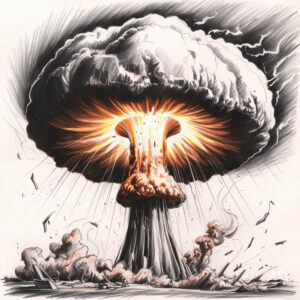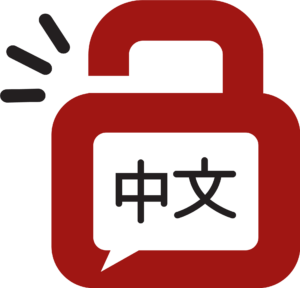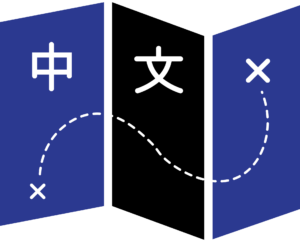 Mnemonics are clever memory techniques you can use to learn and remember more, but this doesn’t mean that you should always use them. If you do, you will end up spending more time on mnemonics than you do engaging with the Chinese language.
Mnemonics are clever memory techniques you can use to learn and remember more, but this doesn’t mean that you should always use them. If you do, you will end up spending more time on mnemonics than you do engaging with the Chinese language.
You have many tools in your learning arsenal, so don’t bring out the nukes unless you have to. They are expensive and cause collateral damage.
Tune in to the Hacking Chinese Podcast to listen to the related episode (#229):
Available on Apple Podcasts, Spotify, YouTube and many other platforms!
Mnemonics: A practical tool for Chinese learning
In this article, I’m going to discuss when to not use mnemonics. Before I get to that, though, it’s necessary to discuss what mnemonics are and what problems they can help us solve. If you already use mnemonics for learning Chinese, you can skip these initial sections and start reading at Limitations of mnemonics in character learning.
Why understanding trumps rote memorisation
Trying to learn Chinese characters by rote is an exercise in futility and frustration. While you can learn to write some characters by brute force of repetition, this strategy becomes less viable the more characters you need to remember.
Rote learning is inefficient because it ignores the importance of understanding. Learning and remembering something that makes sense will always be easier than committing something nonsensical to memory.
Breaking characters into meaningful components
This is why Chinese characters are easier to learn when considered as building blocks. Combining meaningful units is better than treating characters and random jumbles of strokes.
This effectively converts the challenge of learning characters from “learn thousands of random jumbles of strokes” to “learn hundreds of components and how they are combined to form thousands of characters”.
The building blocks of Chinese, part 1: Chinese characters and words in a nutshell
The origins of characters and how mnemonics help
While it’s clearly easier to learn hundreds of simple building blocks, combining them is a challenge in itself. Fortunately, it’s a problem that has several good solutions.
- One of them is to learn the true origin of the compound, which often makes a lot of sense, even thousands of years later. Your best resource to look this up is the Outlier Linguistics Dictionary of Chinese Characters.
- Another popular solution is mnemonics. These are memory techniques that can be employed to memorise anything. They work best for combining small, meaningful units, such as the components in Chinese characters.
Leveraging mnemonics and courses to learn effectively
This has given rise to many methods for learning Chinese characters, the most famous one being Remembering the Hanzi, which I discussed briefly in this podcast episode.
I also include the basics of mnemonics in two of my courses:
- Unlocking Chinese: The Ultimate Course for Beginners
 contains lessons focusing on how to use mnemonics to memorise characters successfully, relying both on actual etymology and made-up memory hooks when necessary.
contains lessons focusing on how to use mnemonics to memorise characters successfully, relying both on actual etymology and made-up memory hooks when necessary.  Hacking Chinese: A Practical Guide to Learning Mandarin also contains a discussion of mnemonics, exploring effective techniques to remember characters and more.
Hacking Chinese: A Practical Guide to Learning Mandarin also contains a discussion of mnemonics, exploring effective techniques to remember characters and more.
Beyond that, I’ve also written several articles about mnemonics, which I recommend in the following order:
- You can’t learn Chinese characters by rote
- Remembering is a skill you can learn
- Sensible character learning: Progress, reminders and reflections
- How to create mnemonics for general or abstract character components
I love mnemonics. They are amazing, and if you’ve never tried using them, you’re in for a treat. But…
Limitations of mnemonics in character learning
Even if we only look at information superficially encoded in a Chinese character, there’s still a lot of information to memorise, including:
 What the character means, including additional meaning
What the character means, including additional meaning- How the character is pronounced (initial, final, tone), including alternate readings and sometimes complex links between these and different meanings
- What the components mean
- How the components are written
- How they are positioned in relation to each other
While it’s possible to design a complex system to memorise all this information, this would be extremely time-consuming and ultimately unnecessary.
You’re likely to end up using mnemonics for their own sake, forgetting that the purpose of using them to learn Chinese characters is to save time.
Time spent on creating and maintaining complex mnemonics is time you could have spent engaging with the language more.
Using mnemonics only when needed
The obvious solution is to use mnemonics only when you need them:
- If you keep forgetting the tone, create a mnemonic for the tone. If you keep forgetting certain components, create a mnemonic to make them stick. If you forget the meaning, create a mnemonic for the meaning.
Then, by extension:
- If you don’t forget the tone, do not create a mnemonic for it. If you don’t forget the components, do not create mnemonics for them. If you don’t forget the meaning, do not waste time on coming up with a mnemonic for it.
The default approach should be to identify building blocks and understand how they fit together. Most students will find that this is already enough in most cases!
Recognising pronunciation patterns without mnemonics
In many characters, there are clues hidden in their structure that can help you figure out the pronunciation without needing detailed mnemonics. In essence, simply understanding how phonetic components work is enough.
For example, consider the characters: 碟, 蝶, 牒, 褋, 褋 and 喋. They have different meanings, but they are all pronounced dié That is because they share the same phonetic component.
Phonetic components, part 1: The key to 80% of all Chinese characters
Phonetic patterns simplify pronunciation learning
While this is a convenient example, it still illustrates the fact that most Chinese characters are not random collections of strokes. You could come up with clever mnemonics for all of these combinations, but since the pattern is regular, there’s no need to.
This works even if the modern pronunciation doesn’t perfectly fit the pronunciation of the phonetic component. Sometimes, the tone is different (样 yàng vs. 羊 yáng), a different initial (很 hěn vs. 艮 gěn), a different final (狼 láng vs. 良 liáng), or a combination of these.
Regardless, these clues are still incredibly valuable for learning and remembering characters and require no mnemonics; simply seeing the pattern is often enough.
A deeper understanding of the Chinese writing system clearly helps here, and if you feel that your knowledge is lacking in this area, you might want to check out my series of articles, starting here: The building blocks of Chinese, part 1: Chinese characters and words in a nutshell.
You should also check out Outlier Linguistics Chinese Character masterclass, which I have reviewed here.
Outlier Chinese Character Masterclass review: Understand more, learn faster, remember longer
Mnemonics are sometimes needed to remember component placement
When it comes to the relative position of components (left-right, top-down etc.), we can also rely on knowledge of the writing system instead of mnemonics.
For example, if you are creating a mnemonic for 洋 yáng, “ocean”, you do not need a mnemonic to remember that the three drops of water belong on the left. Water components in Chinese characters almost always appear on the left. They are also extremely rarely the phonetic component.
This is not always true, however, and there are some particularly tricky cases where mnemonics are highly useful. For example, it seems rather arbitrary on which side the bird component 鸟 is written in compounds relating to bird names:
- On the right: 鹅、鸽、鸭
- On the bottom: 鹰、鸳、鸯
- On the left: 鸵
Here, you clearly want to include relative position in your mnemonic, because even though 鸟 is usually on the right, this is far from always the case.
Chinese characters that share the same components but are still different
Sometimes, several characters share the same components, but are arranged in different ways. In these cases, you have to keep track of where they go to not mix them up. Here are a few examples:
- 蜒 yán, “millipede”, and 蜑 dàn, “egg”
- 怡 yí, “joyful, happy”, and 怠 dài, “idle, slack”
- 忠 zhōng, “loyal”, and 忡 chōng, “grieved”
I have collected many more of these in this article: Chinese characters that share the same components but are still different. Some even have three different versions!
Chinese characters that share the same components but are still different
Use mnemonics only when you need them; don’t nuke the chicken
The upshot of all this is that mnemonics are extremely powerful, but also time-consuming to use. It’s impractical to use them for everything you could in theory use them for, so don’t.
It is crucial to understand that everyone is different. Our strengths, weaknesses, and familiarity with character structure all vary, which means one person might need mnemonics where another person does not.
 The key lesson is that you do not have to do more than necessary. If you want to kill a chicken, you do not need to use a nuclear bomb. That kind of overkill wastes your energy and resources that are better invested elsewhere.
The key lesson is that you do not have to do more than necessary. If you want to kill a chicken, you do not need to use a nuclear bomb. That kind of overkill wastes your energy and resources that are better invested elsewhere.
Conclusion: Don’t use mnemonics for every Chinese character you learn
In summary, mnemonics are a powerful tool for learning Chinese characters, but they should be used judiciously. Over-relying on mnemonics can lead to inefficiency and detract from time spent engaging directly with the language.
Instead, focus on understanding the structure of characters and using mnemonics selectively.
Editors note: This article, originally published in 2013, was rewritten from scratch and massively updated in December 2024.

12 comments
“If you forget the meaning, use mnemonics to figure that out” this made me think… Do most of you use spaced repetition (Anki/Skritter) to recognize (i.e. Chinese -> English) or produce (English -> Chinese), or both?
I’ve been learning characters from the books of Heisig, where the focus in on producing the character given the keyword. English is not my mother tongue, so this creates an additional problem. For example, I didn’t know that plundering and pillaging are different things, so then creating mnemonics that take that difference into account was not so trivial. Perhaps the problem is related to learning the characters in isolation, just from Heisig’s book.
This brings another idea forward: Learning the characters and words after you’ve seen them in context. In practice this would mean reading texts and adding the unknown words into Anki/Skritter, and creating mnemonics for the difficult ones. This is a tedious process to do by hand. It’s possible to make it easier by creating a vocabulary from a given text. It can be done using a word segmenter (ICTCLAS or FudanNLP for example) and a bit of computer programming.
For example, I can take a story or movie subtitles from somewhere, segment it into words, and get a list of all of the words in the text arranged according to their frequency in such a format that it’s easy to add to Skritter. Now the crux of the problem is finding suitable texts. I like reading comics, but this really needs the words to be in text format, not pictures.
I’ve been reading this site on and off for a long time now, and I think that it would benefit greatly from a list or blog entry about different reading/listening/watching resources that many people could have access to. Maybe people could describe to you what they have used? Good resources are of course a matter of opinion.
Hi Eemeli,
I will definitely try to provide more resources in the future. I have done that for music, but I should do something similar for TV, books, online reading, videos and so on. The problem is that writing one article like that easily takes ten times longer than writing any other article and I just don’t have that much time. I’ll see what I can do.
About it being tedious to record words, I think that’s necessary and not necessarily bad. I have manually added most of the 22000 words/characters in my Anki deck and I don’t regret doing it. I think adding the word, looking up sentences and so on is valuable in itself. It’s much more than just mechanically adding something to a list.
(I corrected the link in your comment and deleted your own revision of it, hope this is okay.)
Best,
Olle
Even for native english speakers, the difference between plundering and pillaging is pretty small 🙂 Maybe a real pirate would know but not your average speaker.
For this kind of thing, first of all I don’t over-do my reaction to remembering the wrong one – you are 95% correct and that’s pretty awesome.
Second, I build a mnemonic using wordplay – e.g. “pillaging a drugstore for pills” or “plunder downunder” so as to uniquely identify which variant of the same basic meaning I meant.
For “By means of” I’ve had to include a bi-sexual in the story because I just couldn’t remember the “By” to start with, and there are so many abstract expressions to get confused with.
Over time you get better at distinguishing and the right variant seems to pop into your brain without too much trouble.
I agree with you that context is super useful – frequently once I have seen a character in the wild, it’s much easier for me to remember. Context is your friend.
There is no difference, to plunder and to pillage are the same thing
Thanks for the heads up. My biggest problem with learning Chinese at the moment is that I can’t memorise lessons just by reading through them. Currently I’m reading Assimil Chinese With Ease which provides cool little dialogues with translations and explanations, but when I try to sit down and read through them I get bored because I can’t remember anything the moment I shut my eyes. Mnemonics such as in Heisig’s book have been awesome for me since it makes me visualise a scene rather than gaze at the paper. The infinitely best way for me to learn something is to explain it to someone else, so perhaps I could imagine explaining each sentence in my head to someone…
Anyway, have you seen this: http://countryoftheblind.blogspot.hk/2012/01/mnemonics-for-pronouncing-chinese.html ?
Could you please provide any comments on if you think it would be a good idea. It seems impressive to me, but requires an investment.
Yes, I have read that article and for me personally, it’s a very good example of using nukes to kill the chicken. Most students don’t need that and would be much, much better of learning more about phonetic components and simply studying characters more in general. You could use something like that for tricky cases, but doing that for all characters is exactly what my own article tells you not to do!
I agree with Olle. For me, many of the characters’ pronunciations are easy to remember without any extra effort. That’s because I see them often enough in context. The tricky cases often involve remembering the wrong tone, in which case you could just add a simple element to the story (e.g. color, or I like to add feelings: calm: tone 1, wondering/confused: tone 2, nuisance/annoyance: 3rd, anger: 4th). For the rest, you can just develop something else. Those characters will account for less than 10% of all of them.
A good way to see which tones you know and which not is to read some easy texts aloud. I often notice that the text I could understand 100% was hard to read aloud, meaning that I should focus a bit more of the pronunciation.
I tried Heisig’s book but it was so much work to remember the mnemonic that I quickly dropped it. Now I just try to remember some aspect of the character that’s a trigger and will hopefully help me remember the rest. But the more characters I learn, the harder that gets. Spaced rote repetition, besides actual real-world use, is the only way I’ve found to learn them.
(Learning to write characters is especially hard because no one hand-writes much anymore, and Chinese keyboards use pinyin to find the characters, so there isn’t a lot of opportunity to actually write Chinese characters in real-world use. I’ve talked to college educated Chinese who say they can’t remember how to write a lot of characters anymore because these days they just type them. It’s like how my teen daughter’s English spelling is terrible because she’s become totally reliant on spellcheck and never writes stuff by hand anymore anyway.)